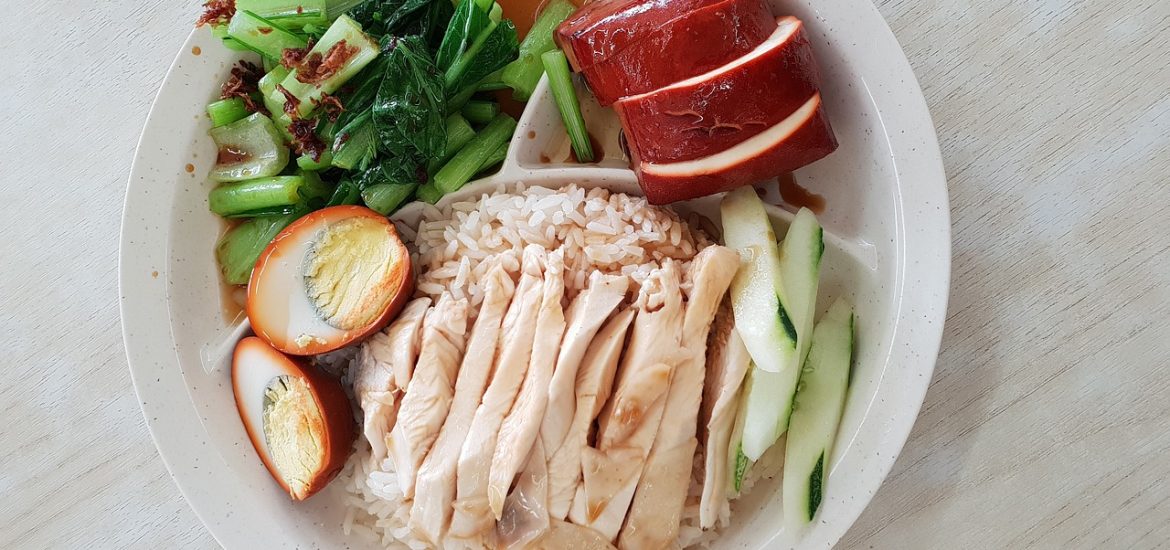Singapore is one of the smallest countries in the world, with a territory covering just 722.5 square kilometers (279.0 square miles). However, when it comes to culinary variety, it’s a vast melting pot of Asian cuisines. Combining influences from China, India, and Malaysia, just to name a few, Singapore’s local foods are a tourist attraction by themselves. Here are just a few dishes that every tourist visiting the Lion City must try.
Hainanese Chicken Rice
This dish has become Singapore’s national dish of sorts, with almost every restaurant and hawker centre serving their own versions. The name is deceptively simple, but the Hainanese cooking technique is anything but. It involves steeping an old, plump chicken into a sub-boiling chicken and pork bone broth until it’s cooked. Because the broth is warm, the chicken takes a bit longer to cook fully so the oils and flavors really seep into the meat. A popular variant of the dish is “baiji,” where the cooked chicken is quickly dipped in ice to give the skin a soft, supple feel. Meanwhile, the rice used in the dish is usually cooked using a separate chicken stock, along with garlic and ginger.
Laksa
Laksa is a marriage of Chinese and Malay cuisine, also known as Peranakan. In Singapore, the more predominant version of laksa is curry laksa, as opposed to assam laksa that’s famous in Malaysia. Curry laksa features a creamy coconut milk sauce, vermicelli noodles, and fried tau pok (beancurd puffs). Depending on where you eat, you may also see fish, shrimp, and cockles included in the dish. You’ll also find Katong laksa in the Katong district, where they cut the vermicelli into small pieces
Bak Kut Teh
If you’re staying in hotels in Chinatown Singapore, it’s a good idea to start your food trip sampling bak kut teh in the nearby hawker centers. The literal translation of this dish’s name is less than appealing: meat bone tea. Bak kut teh is not really tea, of course. It’s an aromatic pork ribs soup made by boiling pork ribs in a carefully blended herbal broth that heavily features garlic, pepper, and star anise. Other spices like cinnamon, cloves, and fennel are used to fine-tune the taste, while ingredients like tofu and mushrooms add some texture. Bak kut teh is often served with oolong tea that’s supposed to help dissolve the pork fat.
Mud Crabs
There are two popular styles to cook hard-shelled mud crabs in Singapore: in a thick, sweet-spicy chili and tomato sauce or with black pepper. For the best results, the crabs are first boiled to prevent the meat from sticking to the shells and then stir-fried with the chosen sauce. Boiling the crabs also helps “open” the meat to allow it to absorb the flavors better. The chili crabs are usually served with fried buns (called mantou) that’s supposed to be dipped into the same sweet-spicy sauce. More cooking styles have come up over the years but these two recipes are a must-try if you want the authentic experience.
Fish Head Curry
A fish head swimming in a bowl of reddish-orange curry sauce might not be an attractive sight for some people, but it certainly is a delicious dish. The most popular fish for this dish is the red snapper, which is why it’s also often called red snapper curry. Said to have originated from the Bengali region, this dish also has roots in Malay and Chinese cuisine. Featuring a standard curry base, a half or whole fish head is stewed along with vegetables like okra and brinjal (eggplant). Indian-style fish head curry is thicker and spicier, while Chinese-style is thinner and sweeter. There’s also the assm-style, which adds a bit of a sour flavor from asam (tamarind fruit).
Tau Hua
After eating plenty of savory dishes, you might want to give your taste buds a break with a sweet dessert like tau hua. If you’ve been to other Southeast Asian countries, you’ve probably encountered something similar like the Philippines’ taho or Thailand’s taohuai. In Singapore, tau hua or tau huay is flavored with a sweet syrup infused with pandan leaves. Popular toppings include tang yuan (glutinous rice balls), ginkgo seeds, and grass jelly. Depending on your preferences, you can eat tau hua hot or cold.
Durian
Known as the “King of Fruits,” durian is Singapore’s national fruit. Its pungent odor (durian is banned in enclosed public spaces in Singapore) might be a turn-off, but you should definitely try the variety of desserts made with durian. From cakes and tarts to candies and even snow ice, you’ll certainly learn to love the unique flavor of the durian. Of course, if you can withstand the smell, you should also give the fruit’s mildly sweet flesh a try.
Trying out different foods and delicacies is a big part of a memorable travel experience. Indeed, there are some people who travel for the express purpose of trying out different cuisines. In Singapore, you’re certainly going to find a wide variety of culinary delights that will make you want to come back again and again.

